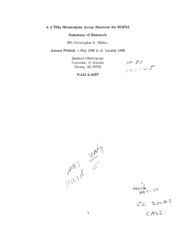
NASA Technical Reports Server (NTRS) 19990040923: A 2 THz Heterodyne Array Receiver for SOFIA PDF
Preview NASA Technical Reports Server (NTRS) 19990040923: A 2 THz Heterodyne Array Receiver for SOFIA
A 2 THz Heterodyne Array Receiver for SOFIA Summary of Research PI: Christopher K. Walker Award Period: 1 May 1996 to 31 January 1998 Steward Observatory //.,- <S<_/ University of Arizona Tucson, AZ 85721 NAG 2-1057 j_ / # ca o Co 1 C ./q _" _ , Summary of Research We proposed to perform a comprehensive design study of a 16-element heterodyne array receiver for SOFIA. The array was designed to utilize hot-electron bolometers in an efficient, low-cost waveguide mount to achieve low noise performance between _ 1500 and 2400 GHz. Due to the prevailing physical conditions in the interstellar medium, this frequency range is one of the richest in the FIR portion of the spectrum. An array designed for this wavelength range will make excellent use of the telescope and the available atmospheric transmission, and will provide a new perspective on stellar, chemical, and galaxy evolution in the present as well as past epochs. A few of the most important molecular and atomic species which the instrument will sample are CII, OI, CO, OH, NII, and CH. The system used the most sensitive detectors available in an efficient optical system. The local oscillator was a compact CO2 pumped far-infrared laser currently under development for SOFIA. The backend spectrometer was an array acousto-optic spectrometer (aAOS). The spectrometer utilizes proven hardware and technologies to provide broadband performance (> 1 GHz per AOS channel) and high spectral resolution (1 MHz) with the maximum sensitivity and minimum complexity and cost. The proposed instrument would be the fastest and most sensitive heterodyne receiver ever to operate in the 1.5 - 2.4 THz band. One of the key technologies developed for the proposed instrument is the laser micromachining of waveguide structures. These structures provide both the optical link between the instrument and the telescope (via an array of efficient feedhorns) and the impedance transformation between the detectors and free space. With the assistance of funds provided from this grant, we were able to fabricate and test the world's first laser micromachined feedhorns. Figure 1 is a photograph of the 2 THz double feedhorn structure designed and constructed under the auspices of this grant. The quality of the waveguide structure is far better than that obtainable using any other fabrication technique. Figure 2 is the beam pattern obtained from it. The beam parameters are an excellent match to what is expected from theory. The success of this experiment demonstrates the viability of using laser micromachined com- ponents in the developement of high performance, large format array receivers. Figure 3 is an illustration of the focal plane array concept we developed for SOFIA base upon this work. Un- fortunately, our instrument proposal was not selected as a first generation SOFIA instrument. However, we have continued our development efforts and will propose to build a 2nd generation instrument based on the same design concepts. Our work under NAG 2-1057 was very rewarding and we appreciate the opportunity provided by NASA to pursue it. The research led directly to publishing 2 papers (listed below) and the award of an NSF grant to our group to construct a laser micromachining system on the University of Arizona campus. 2
